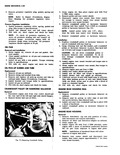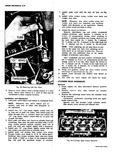Jeep Parts Wiki | Ford Parts Wiki
Home | Search | Browse
|
Corvair Chassis Shop Manual December 1964 |
|
Prev

 Next
Next
6 Remove rear mount bracket and engine skid plate 7 Remove crankshaft pulley or harmonic balancer as outlined 8 Remove engine rear housing assembly NOTE Refer to Repair Procedures Engine Rear Housing for service to engine rear housing Installation 1 Install engine rear housing and torque bolts to specifications 2 Install crankshaft pulley or harmonic balancer as outlined 3 Install engine skid plate and rear mount bracket and torque nuts to specifications 4 Raise engine and connect engine rear mount then torque to specifications 5 Install rear center shield 6 Remove engine lift Tool J 7894 and hardwood block 7 Install oil filter and Delcotron adapter as outlined 8 Install distributor in the same position as when removed then install distributor cap 9 Fill with oil start engine check and adjust timing and check for oil leaks DISTRIBUTOR DRIVE GEAR AND OR FUEL PUMP ECCENTRIC Replacement 1 Remove engine rear housing as outlined 2 Remove distributor drive gear with Tool J 7112 1 and adapter Tool J 7112 2 then remove spacer and fuel pump eccentric CAUTION Be sure Tool J 7112 1 is on distributor drive gear solidly or gear may be damaged during removal 3 Be sure woodruff keys 2 are installed in crankshaft then position fuel pump eccentric and spacer on crankshaft 4 Lubricate crankshaft and distributor drive gear with engine oil and using Tool J 5590 install distributor drive gear until it bottoms 5 Install engine rear housing as outlined VALVE LIFTERS Valve Train Components Hydraulic valve lifters very seldom require attention The lifters are extremely simple in design readjustments are not necessary and servicing of the lifters require only that care and cleanliness be exercised in the handling of parts Locating Noisy Lifters Locate a noisy valve lifter by using a piece of garden hose approximately four feet in length Place one end of the hose near the end of each intake and exhaust valve with the other end of the hose to the ear In this manner the sound is localized making it easy to determine which lifter is at fault Another method is to place a finger on the face of the valve spring retainer If the lifter is not functioning properly a distinct shock will be felt when the valve returns to its seat The general types of valve lifter noise are as follows 1 Hard Rapping Noise Usually caused by the plunger becoming tight in the bore of the lifter body to such an extent that the return spring can no longer push the plunger back up to working position Probable causes are a Excessive varnish or carbon deposit causing abnormal stickiness b Galling or pick up between plunger and bore of lifter body usually caused by an abrasive piece of dirt or metal wedging between plunger and lifter body 2 Moderate Rapping Noise Probable causes are a Excessively high leakdown rate b Leaky check valve seat c Improper adjustment 3 General Noise Throughout the Valve Train This will in almost all cases be a definite indication of insufficient oil supply or improper adjustment 4 Intermittent Clicking Probable causes are a A microscopic piece of dirt momentarily caught between ball seat and check valve ball b In rare cases the ball itself may be out ofround or have a flat spot c Improper adjustment In most cases where noise exists in one or more lifters all lifter units should be removed disassembled cleaned in a solvent reassembled and reinstalled in the engine If dirt varnish carbon etc is shown to exist in one unit it more than likely exists in all the units thus it would only be a matter of time before all lifters caused trouble Removal 1 Drain engine oil then remove lower shrouds as outlined For the right bank remove muffler heat shield 2 Remove valve rocker arm covers and discard gaskets 3 Remove rocker arm nuts rocker arm balls rocker arms and push rods Place in a rack so they may be installed in their original location 4 Remove rocker arm studs and push rod guides then remove and discard rocker arm stud O ring seals fig 32 5 Pull push rod tubes from crankcase bore and remove and discard inner O ring seal fig 33 then remove push rod tube from cylinder head and remove and discard outer O ring seal l v t a s Fig 32 Rocker Arm Studs and Push Rod Guides CORVAXt SHOP MANUAL

 Next
Next